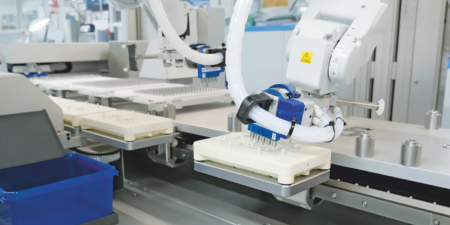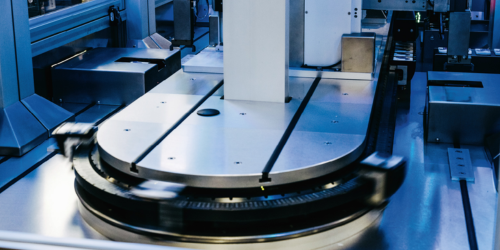As scientific research grows more complex—with emerging fields like cell and gene therapy expanding to 71% of the development pipeline
—laboratories face mounting pressure to innovate.
Modern labs must simultaneously handle an increasingly diverse range of sample types and testing protocols, all while facing significant constraints, including increasing throughput demands, limited floor space, skilled labour shortages, and more. To address these challenges, automation has become essential—and while robotic arms have become standard in many laboratory automation setups, they often require significant programming, maintenance, and floor space.
Technologies like Beckhoff's XPlanar have emerged as innovative alternatives to traditional automation, either as a more adaptable standalone solution for complex laboratory workflows or as a complement to existing robotic systems.
We spoke with Steven Yardley, Beckhoff's Senior Business Development Manager, to understand how XPlanar is reshaping laboratory workflows, as well as the expectations for precision and efficiency in scientific research.
Here are some of the ways technologies like XPlanar are impacting lab automation:
1. Eliminating Manual Sample Handling Errors and Increasing Research Precision
Scientific research demands absolute precision, yet traditional laboratory workflows often struggle to meet increasingly complex experimental requirements. Manual sample handling, for example, introduces variables that can compromise experimental integrity, while conventional transport systems, with their fixed paths and limited movement capabilities, lack the flexibility needed for today's diverse research protocols.
XPlanar represents a fundamental shift in laboratory sample positioning by eliminating these limitations. Its magnetic levitation technology provides contactless sample movement through six degrees of freedom. Unlike traditional methods that rely on mechanical positioning with fixed paths, XPlanar can rotate, transport, and position samples with extraordinary precision, offering a level of control that transforms how researchers interact with their most sensitive materials.
Watch how XPlanar provides the path for state-of-the-art labs and research facilities.
To see how XPlanar redefines workflows and transforms industries, watch our demonstration here.
“With XPlanar, we have a fully sealed stainless steel mover, and you also have the ability to place any non-ferrous material over the tiles,” Yardley said. “These features together create a completely hygienic system that significantly reduces contamination risks—a critical factor when handling sensitive biological samples or sterile materials.”
The positional control and contamination reduction capabilities of XPlanar are particularly valuable in sensitive applications like genomics, drug discovery, and diagnostic testing, where even minor inconsistencies can compromise experimental outcomes.
By eliminating the variability inherent in manual processes, XPlanar ensures research results maintain the highest levels of accuracy and reproducibility.
A recent application demonstrates the technology's transformative potential. By implementing XPlanar, Automation NTH developed a diagnostic device assembly machine that achieved remarkable improvements, including:
- A 10x reduction of its laboratory footprint
- An acceleration of throughput from 5 minutes per device to just 5 seconds
- The ability to leverage high-precision, repeatable positioning while minimizing cleanroom space usage
2. Accelerate Timelines with Simultaneous Multi-Process Workflows
Traditional laboratory workflows typically follow a linear path—samples must complete one process before moving to the next, creating bottlenecks when certain procedures take longer than others. This sequential approach means that a single slow step can delay the entire research pipeline, extending project timelines and limiting throughput.
XPlanar eliminates these constraints through its innovative parallel processing capabilities. Instead of waiting in a queue, samples can be simultaneously routed to multiple testing or processing stations based on availability, dramatically reducing overall processing time.
Beckhoff has demonstrated this capability in its own production facility, where XPlanar manages an IO block manufacturing line with remarkable efficiency.
“We can have 12 different products being processed simultaneously,” Yardley said. "One process might take 10 seconds, another 60, and another 120. It doesn't matter—XPlanar will move each sample to whichever station is free, and once complete, automatically route it to the next appropriate process."
This dynamic routing creates unmatched workflow flexibility, allowing multiple experiments with different protocols to run concurrently while maximizing both equipment utilization and researcher productivity. For time-sensitive applications like drug discovery or diagnostic testing, XPlanar's ability to accelerate complex workflows without sacrificing precision can significantly compress development timelines, potentially bringing critical innovations to market faster.
3. Maximize Limited Laboratory Space and Reduce Operational Costs
Laboratory and cleanroom environments represent some of the most expensive real estate in scientific research, with construction and operating costs often exceeding $1,000 per square foot. Traditional laboratory layouts, however, often consume this valuable space inefficiently, creating significant financial constraints that can limit research scope and capabilities.
XPlanar addresses this challenge through its revolutionary approach to space management, offering a compact, modular design that fundamentally reimagines laboratory workflows. “When you're working with this type of technology, you're going to see a 30 to 50% reduction in floor space,” Yardley said. “Cleanrooms are incredibly expensive per square meter, so this represents a significant cost reduction.”
The system's innovative design delivers operational benefits that extend beyond space optimization. Instead of using conventional mechanical components that require regular maintenance, XPlanar employs magnetic levitation technology that eliminates physical wear. “The system flies just 2 mm above the surface with no friction," Yardley explained. “This means virtually no maintenance, which dramatically improves overall system uptime and reliability.”
4. Redirect Skilled Labour from Routine Tasks to High-Value Research
Modern laboratories face a significant workforce challenge: highly educated professionals spending substantial time on manual, repetitive tasks rather than applying their specialized knowledge.
“You can spend years training a skilled lab technician, only to have them spend their time walking between different pieces of equipment,” Yardley said.
XPlanar directly addresses this inefficiency by automating sample movement and transportation and enabling researchers to redirect their attention to complex problem-solving, data analysis, and innovative research design.
“When automation is deployed intelligently, you're making the workforce more efficient by eliminating mundane and repetitive tasks," Yardley said, explaining how this reallocation of human resources not only accelerates research outcomes but also improves workplace satisfaction, helping research institutions attract and retain top scientific talent in an increasingly competitive environment.
“Today's professionals don't want to perform repetitive work—they want meaningful challenges that leverage their education, experience, and skills.”
5. Simplify Regulatory Compliance and Enhance Research Traceability
Scientific research operates under increasingly stringent regulatory requirements, with compliance documentation creating significant administrative burdens for laboratories. Ensuring accurate tracking of samples, processes, and results is essential for both regulatory approval and research reproducibility.
XPlanar addresses these challenges through its position tracking capabilities. “We have the full traceability of the product as it moves through the system—we know exactly where every single mover is and where it has been,” Yardley said, explaining that this tracking data enables users to create comprehensive records of sample movements and processing steps, which helps minimize administrative overhead and human error while providing visibility into research workflows.

"When you have that full digital record of where every sample has been, you dramatically improve both compliance reporting and experimental reproducibility.”
Get Started with Beckhoff's XPlanar for Laboratory Automation
Get in touch to discuss your laboratory automation goals and to learn more about how Beckhoff's innovative XPlanar technology can transform your research workflows and efficiency.
.png?width=76&height=76&name=Untitled%20(100%20x%20100%20px).png)
%20(500%20x%20500%20px).png?width=700&height=700&name=Untitled%20(100%20x%20100%20px)%20(500%20x%20500%20px).png)

.png?width=855&height=456&name=Revolutionize%20Pharma%20Manufacturing%20(15).png)


.png)